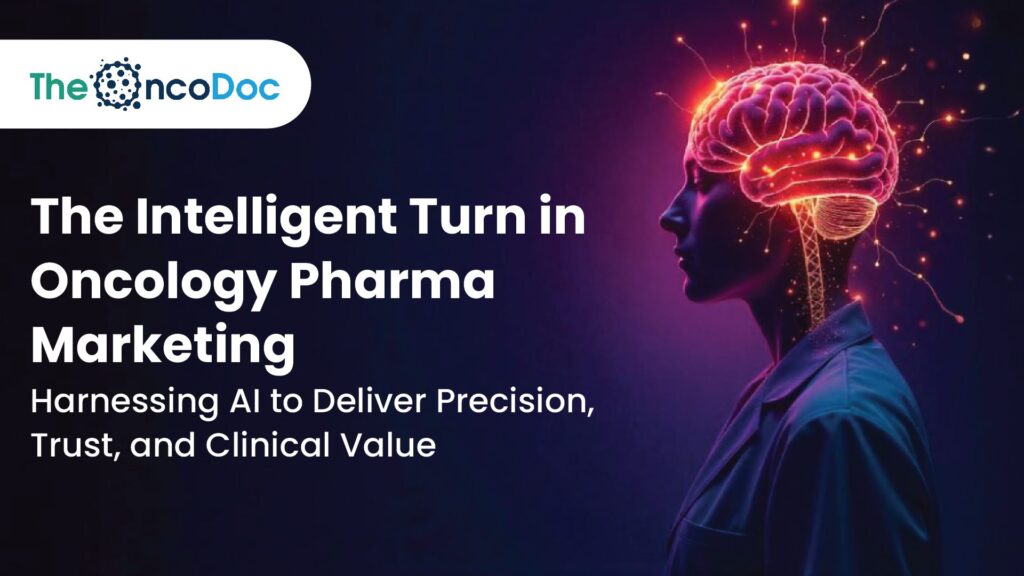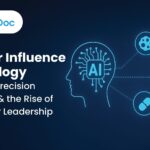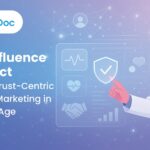Introduction: From Noise to Necessity in Oncology Engagement
Oncology is arguably the most complex, emotionally charged, and scientifically evolving domain in modern medicine. Every decision from diagnosis to third-line treatment is guided not only by data but also by trust, time, and nuance. And yet, much of pharma’s digital outreach continues to chase visibility over value.
In this new era, AI is rewriting the rules of engagement. It doesn’t merely scale content; it adapts it, predicts intent, and delivers clinical precision that mirrors the decision-making complexity oncologists face. Digital campaigns powered by machine learning, real-world data, and behavioral science can now empower clinicians, not distract them.
This article explores how oncology marketers can move beyond traditional tactics and build a new blueprint: one where AI augments personalization, analytics optimize relevance, and influence is measured not in impressions but in improved practice.
1. Rethinking the Role of Digital in Oncology
The old digital KPIs impressions, reach, and CTR- are now insufficient. Oncology is a domain of high-stakes decisions; HCPs demand more than product messaging. They seek tools that align with the clinical reality of tumor boards, guideline ambiguities, and patient-centered care.
The new marketing pillars are
- Precision: Content that adapts to the tumor type, stage, and biomarker
- Context: Messages triggered by real-world clinical behavior
- Utility: Tools that reduce cognitive load and support treatment confidence
- Trust: Personalization that respects boundaries, not just clicks
2. AI as the Engine of Precision Personalization
Artificial intelligence is enabling hyper-targeted campaigns where messages are not just tailored by specialty but by clinical behavior, content history, and moment-in-journey.
Key AI Capabilities:
- Behavioral segmentation (e.g., who reads meta-analyses vs. video summaries)
- Predictive analytics to time content around likely therapy changes
- NLP to understand content interaction tone and sentiment
- Dynamic “next best content” engines triggered by CME behavior or search keywords
These systems don’t just automate; they adapt. When an HCP views a case study on triple-negative breast cancer, the system can recommend a dose management guide followed by a peer-led tumor board invite.
3. Real-World Evidence Meets AI: Smarter Content at Scale
RCTs remain critical, but real-world evidence (RWE) is where AI can make the biggest content impact. AI systems can parse through EHR data, observational studies, and regional case patterns to create localized, timely, and practical content.
Content Possibilities:
- Automated generation of patient cohort summaries
- Visual abstracts comparing trial vs. real-world survival curves
- AI-powered infographics that vary by geography or comorbidity
This enables oncologists to understand, “What does this mean for patients like mine?”
4. Omnichannel Orchestration with AI Guidance
True omnichannel marketing isn’t about being everywhere; it’s about knowing where to be, when, and with what message. AI helps orchestrate this across
- Email campaigns that change tone and depth based on prior opens
- CME modules recommended via WhatsApp, timed around conference season
- Rep visits enhanced with real-time dashboards based on digital behavior
- Personalized app notifications nudging download of new tools
Shows that micro-formats and peer-authority content outperform static brand-led materials across key Indian oncology segments.
5. Enabling Digital Opinion Leaders (DOLs) with AI Infrastructure
AI helps pharma identify and support emerging digital voices -younger oncologists who post case experiences, comment on trials, or answer peer questions on Sermon, ResearchGate, or LinkedIn.
AI uses these methods:
- Graph theory to map peer clusters
- Sentiment analysis to detect credibility
- Topic modelling to detect specialty depth
- Influence trajectory prediction (who’s trending upward in trust)
Pharma marketers can offer these micro-influencers co-branded toolkits, early access to content, or digital podiums to drive peer-led engagement without over-branding.
6. AI + Human Collaboration: Sales, MSLs, and the Marketing Loop
AI does not replace field reps or MSLs; it augments them with insights. Sales teams should be alerted when:
- An oncologist downloads a diagnostic checklist
- A patient management guide is bookmarked
- Webinar content has high dwell time by a user
MSLs, in turn, can inform AI models about:
- New resistance mechanisms being discussed in the field
- Trial interpretations that need clarification
- Regional differences in diagnostic access
This hybrid model makes outreach proactive, contextual, and resource-efficient.
7. Micro-Content for Macro Retention: Designing for Digital Behavior
The average oncologist skims content in 3–5 minute windows between patients. AI can help determine
- Which titles trigger scrolls
- Which formats lead to repeat visits
- Where drop-offs occur in videos
Winning formats:
- 90-second MoA animations
- Slide carousel summaries of ASCO updates
- Patient journey explainer in WhatsApp shareable format
- Auto-translated visual abstracts
Case-based and visual formats result in longer engagement, indicating deeper content interaction. Voice and video formats outperform text-heavy material.
8. Ethical Guardrails for AI Marketing in Oncology
AI personalization must be transparent, compliant, and ethical. Oncology content cannot overstep into bias, off-label inference, or algorithmic opacity.
Guardrail Strategies:
- Train AI models only on MLR-approved, peer-reviewed content
- Allow HCP opt-out from AI-based targeting
- Include transparency tags: “This content was recommended based on your past interaction with the XYZ webinar.”
- Audit AI decisions quarterly for content equity (e.g., no over-targeting of high-prescribers only)
shows compliance and transparency at the top of the list of strategic concerns, requiring close alignment between digital, legal, and medical teams.
9. AI for Post-Engagement Impact Assessment
Traditional pharma metrics measure reach. But AI allows us to assess influence on behavior:
- Did webinar attendees change prescribing behavior?
- Did a biomarker calculator increase test orders?
- Did peer content reduce therapy switching hesitancy?
Modern platforms now use multi-touch attribution models and intent scoring based on content path analysis. This provides brand teams with ROI grounded in clinical relevance, not just marketing optics.
10. Case Study: AI-Augmented Oncology Launch in Gastrointestinal Cancer
Scenario: A mid-sized pharma company launched a first-in-class therapy targeting BRAF V600E mutations in metastatic CRC. The awareness was low outside metros.
Strategy:
- AI-identified 92 regional oncologists with high likelihood of relevant cases
- Co-created micro-content with 6 DOLs explaining testing and sequencing
- Used WhatsApp-based CME sequences tailored by region and engagement timing
- Automated rep dashboards showed which clinicians consumed which assets
Results (3 months):
- 31% increase in test ordering for BRAF mutation
- 46% of HCPs said the campaign improved sequencing clarity
- Average time spent on digital tools = 7.2 mins
- +22% brand recall compared to metro-focused push-only campaign
11. Preparing for Tomorrow: Predictive, Adaptive Pharma Marketing
AI’s potential goes far beyond targeting. Emerging capabilities will include
- Digital twin modelling of HCP preferences
- Adaptive CME modules that shift based on quiz response accuracy
- Autonomous content assistants that synthesize 3rd-party trial data into brand-aligned visuals
- Predictive ROI modelling that advises pre-launch spend by region
The most forward-looking pharma marketers will not merely deliver messages but co-navigate care complexity with HCPs.
12. Expanding the Ecosystem: Engaging the Entire Oncology Care Team
The success of any oncology intervention isn’t just determined by the prescribing oncologist. Radiologists, pathologists, oncology nurses, surgeons, and palliative care teams all contribute to key clinical decisions. Pharma marketing, especially when powered by AI, must shift to a network-centric strategy that delivers tailored, time-sensitive content to each stakeholder.
AI-driven tactics include:
- Mapping clinical handoff points (e.g., biopsy to treatment decision)
- Sending tailored visuals to surgeons on post-op systemic therapy options
- Deploying voice-led updates for nurses on toxicity mitigation protocols
- Sharing testing guidelines with diagnostic pathologists via WhatsApp in regional languages
This holistic engagement creates a shared knowledge infrastructure where the brand becomes a platform for clinical collaboration, not just a vendor.
13. Patient-Centered Metrics: Beyond HCP Engagement
Traditionally, oncology brand metrics focused on HCP behavior, opens, clicks, and scripts. But now, pharma can begin measuring downstream patient impact using AI-linked dashboards and RWE signals.
Trackable AI-augmented indicators:
- Diagnostic test orders following CME participation
- Increase in guideline-aligned prescriptions post-engagement
- Patient tool downloads and their link to adherence duration
- Patient support app usage and reported quality-of-life scores
This data enables pharma to correlate education with outcome, making marketing not just influential but transformative.
14. Feedback-Driven Personalization: Building a Learning Content Loop
The most powerful digital ecosystems don’t just deliver content; they learn from every interaction. Pharma brands can integrate:
- Field intelligence from reps and MSLs
- Platform data (time-on-page, scroll depth, quiz accuracy)
- Engagement patterns (drop-off points, forward/share rates)
AI can then
- Refine user profiles monthly
- Adjust next-best-action logic
- Swap out underperforming formats for modular improvements
This closed-loop architecture turns static campaigns into responsive, ever-improving journeys.
15. Localization Strategy: Going Beyond Translation
India and other emerging markets present a deeply fragmented landscape of language, infrastructure, and digital maturity. AI enables not just linguistic adaptation but behavioral localization.
Strategies that work:
- Voice notes in vernaculars instead of PDFs for Tier 2 HCPs
- Geo-personalized CME invites for state-based oncology chapters
- Auto-captioned case videos adjusted for local terminology
- Regional influencer content using hyper-local analogies (e.g., tobacco-induced oral cancer)
Localized campaigns consistently outperform national content by 2–3x in Tier 2/3 cities.
16. Pharma’s Emerging Role as Digital Partner in Cancer Care
As digital oncology evolves, pharma marketers will increasingly become enablers of health infrastructure:
- Co-developing AI-powered risk assessment tools with NGOs
- Offering clinical calculators through telemedicine platforms
- Embedding education nudges into EMRs/EHRs
- Collaborating with insurers to automate eligibility-based content targeting
This changes pharma’s role from campaign planner to care collaborator, a position of deep, durable strategic value.
Conclusion: Repositioning Pharma as a Digital Partner in Oncology
AI in oncology marketing is not about scale; it’s about precision, timing, and trust. Brand teams who embrace personalization with integrity, build micro-influence ethically, and measure outcomes beyond clicks will become true partners in the practice of oncology.
From tactical promotion to strategic enablement, the journey is clear: add clinical value, or risk being digitally invisible.
The Oncodoc team is a group of passionate healthcare and marketing professionals dedicated to delivering accurate, engaging, and impactful content. With expertise across medical research, digital strategy, and clinical communication, the team focuses on empowering healthcare professionals and patients alike. Through evidence-based insights and innovative storytelling, Hidoc aims to bridge the gap between medicine and digital engagement, promoting wellness and informed decision-making.



